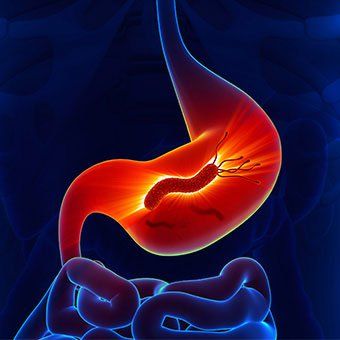Article Reviewed by Dr. Hồ Thị Hồng Tho, Neonatologist, Pediatrics Department - Vinmec Phú Quốc International Hospital.
The health of a child’s digestive system is one of the top concerns for parents caring for young children. A healthy digestive system lays the foundation for a child’s overall development. But when does a child’s digestive system become fully developed?
1. When Does a Child’s Digestive System Fully Develop?
The first few years of life are a period of rapid development for a child’s digestive system, both structurally and functionally. However, a child’s nutritional and energy needs during this time are disproportionately high compared to the physiological capacity of the digestive system. Understanding the timeline and characteristics of digestive development at each stage can help parents proactively prevent potential digestive issues in their child.
The digestive system is a complex chain of interconnected organs, including the mouth, esophagus, stomach, intestines, liver, and pancreas. Each organ plays an indispensable role in the overall functioning and development of digestion.
1.1. Mouth
At birth, a baby’s jaw structure is not fully developed. The mouth is small, but the tongue is relatively large, and the tongue’s papillae are well-developed to help the baby latch onto the mother’s breast for effective feeding. The mucous membrane in the baby’s oral cavity is thin and rich in blood vessels, making it highly susceptible to injury, fungal infections, or bacterial contamination. Parents should regularly clean the baby’s mouth to ensure good oral hygiene.
Salivary glands begin to mature around 3–4 months of age, which is why breast milk or formula is the ideal food during this stage.
Around 4–6 months of age, babies may start drooling due to teething, which stimulates the trigeminal nerve (cranial nerve V). Saliva contains enzymes like amylase and maltase, which aid in the digestion of starches, and the activity of these enzymes increases with age.
Teething milestones:
- Newborns are toothless.
- Milk teeth start erupting around 4–6 months and are usually complete (20 teeth) by 24–30 months.
- By 1 year old, the oral cavity is nearly fully developed.
- Permanent teeth begin to emerge at 6 years old, gradually replacing milk teeth.
1.2. Esophagus
At birth, the esophagus is funnel-shaped, with thin walls and underdeveloped muscle tone. This makes babies prone to reflux and regurgitation. The esophagus lengthens and strengthens as the child grows, reaching adult size in adolescence:
- Newborn: 10 – 11 cm
- 1 year: 12 cm
- 5 years: 16 cm
- 10 years: 18 cm
- 15 years: 20 cm
- Adult: 25 – 32 cm
1.3. Stomach
A newborn’s stomach is round, positioned horizontally, and located relatively high in the abdomen. The stomach muscles, especially the lower esophageal sphincter, are weak and underdeveloped, making it prone to deformity and reflux after feeding. Meanwhile, the pyloric sphincter (at the stomach’s exit) is more developed, tightly closing to prevent food from entering the intestines too quickly. Therefore, children are very likely to reflux after eating too much, especially in the first 6 months of life.
The timeline for stomach development varies from child to child: Some children achieve basic digestive maturity by 3 months. Others take 6–12 months to reach this stage.
To reduce reflux due to an immature lower esophageal sphincter, parents should:
- Hold the baby upright after feeding.
- Feed smaller quantities at regular intervals (2.5–3 hours apart).
- Avoid overfeeding.
When a child turns 1 year old, the stomach, which was positioned horizontally during infancy, begins to shift to a vertical position as the child starts walking. At this stage, the stomach takes on a long, elongated shape. From the age of 2 onward, the structure of the stomach continues to develop and becomes more refined, resembling the stomach of an adult.

1.4. Intestines
A child’s intestines are significantly longer in proportion to their body size compared to adults. At 6 months of age, the large intestine is about 6 times the child’s body length, whereas in adults, it is only 4 times their height.
A child's intestines are characterized by a relatively large surface area, thin intestinal walls, a dense blood vessel network, and high permeability. During the early years of life, as the intestinal system gradually matures, parents need to take proper care of their child’s digestive health. This is crucial to maximize the intestines' rapid absorption capacity while preventing infections caused by loose connections between intestinal epithelial cells, which may allow harmful bacteria to enter.
The mesentery (intestinal attachment) is long and loosely connected, making the intestines prone to twisting (intestinal volvulus). In children under 1 year old, the position of the appendix is often variable, typically located behind the cecum. This makes diagnosing appendicitis in young children more challenging.
By age 7, the digestive tract’s anatomy and physiology closely resemble those of an adult, including a fully developed gut microbiome.
1.5. Pancreas
The pancreas produces essential digestive enzymes such as trypsin, lipase, and amylase to break down proteins, fats, and carbohydrates into simpler molecules that are easier to absorb. In the first few years of life, pancreatic enzyme production is immature, which is why breast milk is the most suitable food for infants.
1.6. Liver
A newborn’s liver accounts for 4.4% of their body weight. It is rich in blood vessels, but its cells are not fully mature. Along with pancreatic enzymes, bile secreted by the liver plays a crucial role in breaking down complex compounds into simpler molecules for easier absorption.
Due to lower levels of digestive enzymes in children compared to adults, they are more prone to digestive disorders and poor nutrient absorption.

2. Caring for an Immature Digestive System
A child’s immature digestive system is prone to issues like bloating, constipation, reflux, diarrhea, and poor appetite. Parents can become their child’s “personal doctor” by learning how to care for and support digestive health at home.
2.1. For Children Under 6 Months
- Breastfeed within the first hour after birth to stimulate milk production. Colostrum (the first milk) helps prevent neonatal infections, promotes stool elimination, and reduces jaundice.
- How you breastfeed your baby will determine whether he gets enough milk or not. You need to breastfeed your baby according to his needs and stomach capacity. Ensure the baby empties one breast before switching to the other to access the fat-rich hindmilk.
- Exclusively breastfeed for the first 6 months, avoiding all other foods or liquids, including water. Formula-fed infants are more prone to digestive problems than breastfed ones.
2.2. For Children Aged 6–24 Months
- For children aged 6–24 months, breast milk remains the primary source of nutrition and energy. Parents should continue breastfeeding until the child is 2 years old while introducing complementary solid foods once the child turns 6 months.
- Introducing solids at 6 months is appropriate because, at this age, children begin showing an interest in food. They also start teething, learning to use their tongue to move food, and chewing with their developing jaw. By this stage, their digestive system is capable of processing solid foods.
- Complementary foods should be diverse to meet the child’s needs for physical, mental, and cognitive development. Ensure meals include all four essential food groups: carbohydrates, proteins, fats, vitamins and minerals.
- Gradually increase the number of meals and the quantity of food per meal to match the growing capacity of the child’s stomach.
- Provide an additional 400–600 ml of boiled, cooled water daily to support hydration.
- Gently massage the child’s abdomen to stimulate bowel movements and enhance intestinal activity. Establish regular bowel habits by encouraging the child to have a routine for using the toilet and avoiding withholding stools.
- Incorporate fiber-rich foods like fruits (oranges, papaya, dragon fruit) and vegetables to promote healthy digestion.
A child’s digestive system differs significantly from an adult’s, requiring special care and attention. Providing a balanced diet tailored to their developmental stage and monitoring for signs of digestive distress can ensure their health and optimal growth.
To ensure children are healthy and develop well, they need a diet that is both quantitatively sufficient and qualitatively balanced. If a child does not receive adequate and balanced nutrition, they may develop deficiencies or excesses that negatively affect their overall development—physically, mentally, and emotionally.
Improper eating habits can lead to a lack of essential micronutrients, causing issues such as poor appetite, stunted growth, and malabsorption. If these signs are observed, parents should consider providing supplements containing lysine, essential micronutrients, and vitamins like zinc, chromium, selenium, and B vitamins. These nutrients help meet the child’s dietary needs, support digestion, enhance nutrient absorption, and improve poor appetite, ultimately helping children eat better and grow stronger.
Parents can explore more resources:
- Signs Your Child May Be Deficient in Zinc
- Micronutrient Deficiency and Stunted Growth in Children
To arrange an appointment, please call HOTLINE or make your reservation directly HERE. You may also download the MyVinmec app to schedule appointments faster and manage your reservations more conveniently.













